| Solar eclipse of October 3, 2005 | |
|---|---|
 Annular from Madrid, Spain Annular from Madrid, Spain | |
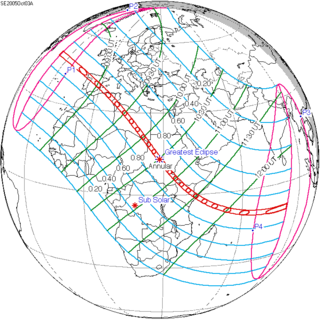 Map Map | |
| Type of eclipse | |
| Nature | Annular |
| Gamma | 0.3306 |
| Magnitude | 0.9576 |
| Maximum eclipse | |
| Duration | 272 s (4 min 32 s) |
| Coordinates | 12°54′N 28°42′E / 12.9°N 28.7°E / 12.9; 28.7 |
| Max. width of band | 162 km (101 mi) |
| Times (UTC) | |
| (P1) Partial begin | 3:53:56 |
| (U1) Total begin | 18:40:59 |
| Greatest eclipse | 10:32:47 |
| (U4) Total end | 1:22:35 |
| (P4) Partial end | 24:27:52 |
| References | |
| Saros | 134 (43 of 71) |
| Catalog # (SE5000) | 9520 |
An annular solar eclipse occurred at the Moon's descending node of orbit on Monday, October 3, 2005, with a magnitude of 0.958. A solar eclipse occurs when the Moon passes between Earth and the Sun, thereby totally or partly obscuring the image of the Sun for a viewer on Earth. An annular solar eclipse occurs when the Moon's apparent diameter is smaller than the Sun's, blocking most of the Sun's light and causing the Sun to look like an annulus (ring). An annular eclipse appears as a partial eclipse over a region of the Earth thousands of kilometres wide. Occurring about 4.75 days after apogee (on September 28, 2005, at 16:20 UTC), the Moon's apparent diameter was smaller.
Annularity was visible from a narrow corridor through Portugal, Spain, Algeria, Tunisia, Libya, Chad, Sudan, Ethiopia, Kenya and Somalia. A partial eclipse was seen from the much broader path of the Moon's penumbra, including most of Europe, Africa, the Middle East, and South Asia. Another solar eclipse in Africa occurred just 6 months later.
Visibility
The path of the eclipse began in the North Atlantic ocean at 08:41 universal time (UT). The antumbra reached Madrid, Spain at 08:56 UT, lasting four minutes and eleven seconds and 90% of the Sun was covered by the Moon. The antumbra reached Algiers at 09:05 UT, then passed through Tunisia and Libya before heading southeast through Sudan, Kenya and Somalia. The shadow then moved out over the Indian Ocean until it terminated at sunset, 12:22 UT.
The maximum eclipse duration occurred in central Sudan at 10:31:42 UT, where it lasted for 4m 31s when the Sun was 71° above the horizon.
The motion of the shadow was supersonic and it generated gravity waves that were detectable as disturbances in the ionosphere. These gravity waves originate in the thermosphere at an altitude of about 180 km. Because of the obscuration of solar radiation, the ionization level dropped by 70% during the eclipse. The eclipse caused a 1–1.4 K drop in the temperature of the ionosphere.
Images
-
 Satellite image showing the Moon's shadow over East Africa
Satellite image showing the Moon's shadow over East Africa
-
 Animation from Medina del Campo, Spain
Animation from Medina del Campo, Spain
-
 Santa Maria de Lamas, Portugal (9:00 UTC)
Santa Maria de Lamas, Portugal (9:00 UTC)
-
Eclipse projection through leaves in St. Julian's, Malta
-
 Saintes, France (9:36 UTC)
Saintes, France (9:36 UTC)
-
 Chennai, India (11:33 UTC)
Chennai, India (11:33 UTC)
-
 Eclipse sequence from Degania A, Israel
Eclipse sequence from Degania A, Israel
Eclipse details
Shown below are two tables displaying details about this particular solar eclipse. The first table outlines times at which the moon's penumbra or umbra attains the specific parameter, and the second table describes various other parameters pertaining to this eclipse.
| Event | Time (UTC) |
|---|---|
| First Penumbral External Contact | 2005 October 03 at 07:36:39.6 UTC |
| First Umbral External Contact | 2005 October 03 at 08:42:04.1 UTC |
| First Central Line | 2005 October 03 at 08:44:06.1 UTC |
| First Umbral Internal Contact | 2005 October 03 at 08:46:08.3 UTC |
| First Penumbral Internal Contact | 2005 October 03 at 10:00:20.1 UTC |
| Equatorial Conjunction | 2005 October 03 at 10:11:46.9 UTC |
| Ecliptic Conjunction | 2005 October 03 at 10:28:57.3 UTC |
| Greatest Eclipse | 2005 October 03 at 10:32:47.3 UTC |
| Greatest Duration | 2005 October 03 at 10:38:04.7 UTC |
| Last Penumbral Internal Contact | 2005 October 03 at 11:05:45.4 UTC |
| Last Umbral Internal Contact | 2005 October 03 at 12:19:41.4 UTC |
| Last Central Line | 2005 October 03 at 12:21:40.9 UTC |
| Last Umbral External Contact | 2005 October 03 at 12:23:40.2 UTC |
| Last Penumbral External Contact | 2005 October 03 at 13:28:57.9 UTC |
| Parameter | Value |
|---|---|
| Eclipse Magnitude | 0.95759 |
| Eclipse Obscuration | 0.91698 |
| Gamma | 0.33058 |
| Sun Right Ascension | 12h37m55.0s |
| Sun Declination | -04°05'04.2" |
| Sun Semi-Diameter | 15'59.1" |
| Sun Equatorial Horizontal Parallax | 08.8" |
| Moon Right Ascension | 12h38m30.3s |
| Moon Declination | -03°49'04.7" |
| Moon Semi-Diameter | 15'05.2" |
| Moon Equatorial Horizontal Parallax | 0°55'22.1" |
| ΔT | 64.8 s |
Eclipse season
See also: Eclipse cycleThis eclipse is part of an eclipse season, a period, roughly every six months, when eclipses occur. Only two (or occasionally three) eclipse seasons occur each year, and each season lasts about 35 days and repeats just short of six months (173 days) later; thus two full eclipse seasons always occur each year. Either two or three eclipses happen each eclipse season. In the sequence below, each eclipse is separated by a fortnight.
| October 3 Descending node (new moon) |
October 17 Ascending node (full moon) |
|---|---|
 |

|
| Annular solar eclipse Solar Saros 134 |
Partial lunar eclipse Lunar Saros 146 |
Related eclipses
Eclipses in 2005
- A hybrid solar eclipse on April 8.
- A penumbral lunar eclipse on April 24.
- An annular solar eclipse on October 3.
- A partial lunar eclipse on October 17.
Metonic
- Preceded by: Solar eclipse of December 14, 2001
- Followed by: Solar eclipse of July 22, 2009
Tzolkinex
- Preceded by: Solar eclipse of August 22, 1998
- Followed by: Solar eclipse of November 13, 2012
Half-Saros
- Preceded by: Lunar eclipse of September 27, 1996
- Followed by: Lunar eclipse of October 8, 2014
Tritos
- Preceded by: Solar eclipse of November 3, 1994
- Followed by: Solar eclipse of September 1, 2016
Solar Saros 134
- Preceded by: Solar eclipse of September 23, 1987
- Followed by: Solar eclipse of October 14, 2023
Inex
- Preceded by: Solar eclipse of October 23, 1976
- Followed by: Solar eclipse of September 12, 2034
Triad
- Preceded by: Solar eclipse of December 3, 1918
- Followed by: Solar eclipse of August 3, 2092
Solar eclipses of 2004–2007
This eclipse is a member of a semester series. An eclipse in a semester series of solar eclipses repeats approximately every 177 days and 4 hours (a semester) at alternating nodes of the Moon's orbit.
| Solar eclipse series sets from 2004 to 2007 | ||||||
|---|---|---|---|---|---|---|
| Ascending node | Descending node | |||||
| Saros | Map | Gamma | Saros | Map | Gamma | |
| 119 | April 19, 2004 Partial |
−1.13345 | 124 | October 14, 2004 Partial |
1.03481 | |
129 Partial in Naiguatá, Venezuela |
April 8, 2005 Hybrid |
−0.34733 | 134 Annularity in Madrid, Spain |
October 3, 2005 Annular |
0.33058 | |
139 Totality in Side, Turkey |
March 29, 2006 Total |
0.38433 | 144 Partial in São Paulo, Brazil |
September 22, 2006 Annular |
−0.40624 | |
149 Partial in Jaipur, India |
March 19, 2007 Partial |
1.07277 | 154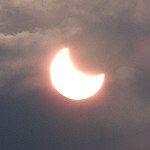 Partial in Córdoba, Argentina |
September 11, 2007 Partial |
−1.12552 | |
Saros 134
This eclipse is a part of Saros series 134, repeating every 18 years, 11 days, and containing 71 events. The series started with a partial solar eclipse on June 22, 1248. It contains total eclipses from October 9, 1428 through December 24, 1554; hybrid eclipses from January 3, 1573 through June 27, 1843; and annular eclipses from July 8, 1861 through May 21, 2384. The series ends at member 72 as a partial eclipse on August 6, 2510. Its eclipses are tabulated in three columns; every third eclipse in the same column is one exeligmos apart, so they all cast shadows over approximately the same parts of the Earth.
The longest duration of totality was produced by member 11 at 1 minutes, 30 seconds on October 9, 1428, and the longest duration of annularity will be produced by member 52 at 10 minutes, 55 seconds on January 10, 2168. All eclipses in this series occur at the Moon’s descending node of orbit.
| Series members 32–53 occur between 1801 and 2200: | ||
|---|---|---|
| 32 | 33 | 34 |
 June 6, 1807 |
 June 16, 1825 |
 June 27, 1843 |
| 35 | 36 | 37 |
 July 8, 1861 |
 July 19, 1879 |
 July 29, 1897 |
| 38 | 39 | 40 |
 August 10, 1915 |
 August 21, 1933 |
 September 1, 1951 |
| 41 | 42 | 43 |
 September 11, 1969 |
 September 23, 1987 |
 October 3, 2005 |
| 44 | 45 | 46 |
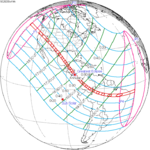 October 14, 2023 |
 October 25, 2041 |
 November 5, 2059 |
| 47 | 48 | 49 |
 November 15, 2077 |
 November 27, 2095 |
 December 8, 2113 |
| 50 | 51 | 52 |
 December 19, 2131 |
 December 30, 2149 |
 January 10, 2168 |
| 53 | ||
 January 20, 2186 | ||
Metonic series
The metonic series repeats eclipses every 19 years (6939.69 days), lasting about 5 cycles. Eclipses occur in nearly the same calendar date. In addition, the octon subseries repeats 1/5 of that or every 3.8 years (1387.94 days). All eclipses in this table occur at the Moon's descending node.
| 21 eclipse events between July 22, 1971 and July 22, 2047 | ||||
|---|---|---|---|---|
| July 22 | May 9–11 | February 26–27 | December 14–15 | October 2–3 |
| 116 | 118 | 120 | 122 | 124 |
 July 22, 1971 |
 May 11, 1975 |
 February 26, 1979 |
 December 15, 1982 |
 October 3, 1986 |
| 126 | 128 | 130 | 132 | 134 |
 July 22, 1990 |
 May 10, 1994 |
 February 26, 1998 |
 December 14, 2001 |
 October 3, 2005 |
| 136 | 138 | 140 | 142 | 144 |
 July 22, 2009 |
 May 10, 2013 |
 February 26, 2017 |
 December 14, 2020 |
 October 2, 2024 |
| 146 | 148 | 150 | 152 | 154 |
 July 22, 2028 |
 May 9, 2032 |
 February 27, 2036 |
 December 15, 2039 |
 October 3, 2043 |
| 156 | ||||
 July 22, 2047 | ||||
Tritos series
This eclipse is a part of a tritos cycle, repeating at alternating nodes every 135 synodic months (≈ 3986.63 days, or 11 years minus 1 month). Their appearance and longitude are irregular due to a lack of synchronization with the anomalistic month (period of perigee), but groupings of 3 tritos cycles (≈ 33 years minus 3 months) come close (≈ 434.044 anomalistic months), so eclipses are similar in these groupings.
| Series members between 1801 and 2200 | ||||
|---|---|---|---|---|
 April 14, 1809 (Saros 116) |
 March 14, 1820 (Saros 117) |
 February 12, 1831 (Saros 118) |
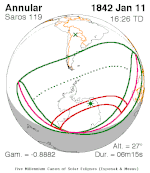 January 11, 1842 (Saros 119) |
 December 11, 1852 (Saros 120) |
 November 11, 1863 (Saros 121) |
 October 10, 1874 (Saros 122) |
 September 8, 1885 (Saros 123) |
 August 9, 1896 (Saros 124) |
 July 10, 1907 (Saros 125) |
 June 8, 1918 (Saros 126) |
 May 9, 1929 (Saros 127) |
 April 7, 1940 (Saros 128) |
 March 7, 1951 (Saros 129) |
 February 5, 1962 (Saros 130) |
 January 4, 1973 (Saros 131) |
 December 4, 1983 (Saros 132) |
 November 3, 1994 (Saros 133) |
 October 3, 2005 (Saros 134) |
 September 1, 2016 (Saros 135) |
 August 2, 2027 (Saros 136) |
 July 2, 2038 (Saros 137) |
 May 31, 2049 (Saros 138) |
 April 30, 2060 (Saros 139) |
 March 31, 2071 (Saros 140) |
 February 27, 2082 (Saros 141) |
 January 27, 2093 (Saros 142) |
 December 29, 2103 (Saros 143) |
 November 27, 2114 (Saros 144) |
 October 26, 2125 (Saros 145) |
 September 26, 2136 (Saros 146) |
 August 26, 2147 (Saros 147) |
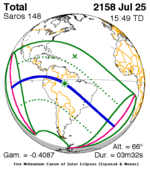 July 25, 2158 (Saros 148) |
 June 25, 2169 (Saros 149) |
 May 24, 2180 (Saros 150) |
 April 23, 2191 (Saros 151) | ||||
Inex series
This eclipse is a part of the long period inex cycle, repeating at alternating nodes, every 358 synodic months (≈ 10,571.95 days, or 29 years minus 20 days). Their appearance and longitude are irregular due to a lack of synchronization with the anomalistic month (period of perigee). However, groupings of 3 inex cycles (≈ 87 years minus 2 months) comes close (≈ 1,151.02 anomalistic months), so eclipses are similar in these groupings.
| Series members between 1801 and 2200 | ||
|---|---|---|
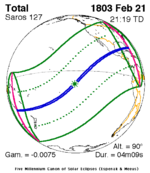 February 21, 1803 (Saros 127) |
 February 1, 1832 (Saros 128) |
 January 11, 1861 (Saros 129) |
 December 22, 1889 (Saros 130) |
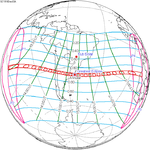 December 3, 1918 (Saros 131) |
 November 12, 1947 (Saros 132) |
 October 23, 1976 (Saros 133) |
 October 3, 2005 (Saros 134) |
 September 12, 2034 (Saros 135) |
 August 24, 2063 (Saros 136) |
 August 3, 2092 (Saros 137) |
 July 14, 2121 (Saros 138) |
 June 25, 2150 (Saros 139) |
 June 5, 2179 (Saros 140) |
|
Notes
- "October 3, 2005 Annular Solar Eclipse". timeanddate. Retrieved 11 August 2024.
- "From Portugal to Burundi: Thousands gather to catch glimpse of annular eclipse". The Vincennes Sun-Commercial. 2005-10-04. p. 14. Retrieved 2023-10-25 – via Newspapers.com.
- "Rare solar eclipse gives Spain, parts of Africa a dazzling view". Arizona Daily Star. 2005-10-04. p. 2. Retrieved 2023-10-25 – via Newspapers.com.
- "Moon Distances for London, United Kingdom, England". timeanddate. Retrieved 11 August 2024.
- ^ Espenak, Fred. "Annular Solar Eclipse of 2005 October 03". NASA/GSFC. Retrieved 2009-09-23.
- Jakowski, N.; et al. (April 2008). "Ionospheric behavior over Europe during the solar eclipse of 3 October 2005". Journal of Atmospheric and Solar-Terrestrial Physics. 70 (6): 836–853. Bibcode:2008JASTP..70..836J. doi:10.1016/j.jastp.2007.02.016.
- Šauli, P.; et al. (December 2007). "Acoustic–gravity waves during solar eclipses: Detection and characterization using wavelet transforms" (PDF). Journal of Atmospheric and Solar-Terrestrial Physics. 69 (17–18): 2465–2484. Bibcode:2007JASTP..69.2465S. doi:10.1016/j.jastp.2007.06.012. S2CID 54722046.
- Burmaka, V. P.; et al. (2007). "Tropospheric-ionospheric effects of the 3 October 2005 partial solar eclipse in Kharkiv". Kosmichna Nauka I Tekhnologiya. 13 (6): 74–86. Bibcode:2007KosNT..13f..74B. doi:10.15407/knit2007.06.074.
- "Annular Solar Eclipse of 2005 Oct 03". EclipseWise.com. Retrieved 11 August 2024.
- van Gent, R.H. "Solar- and Lunar-Eclipse Predictions from Antiquity to the Present". A Catalogue of Eclipse Cycles. Utrecht University. Retrieved 6 October 2018.
- "NASA - Catalog of Solar Eclipses of Saros 134". eclipse.gsfc.nasa.gov.
References
- Earth visibility chart and eclipse statistics Eclipse Predictions by Fred Espenak, NASA/GSFC
Photos:
- Photos of solar eclipse around the world
- Spaceweather.com solar eclipse gallery
- Annular Solar Eclipse at High Resolution APOD 10/5/2005, annularity from Spain
- Annular Eclipse Madrid APOD 10/7/2005, annularity from Buen Retiro Park, Madrid, Spain
- Annular Eclipse Shirt APOD 10/14/2005, from Madrid, Spain



